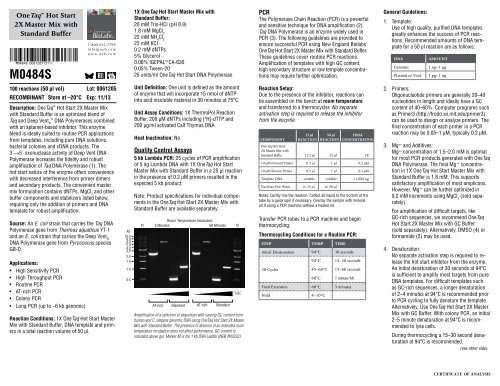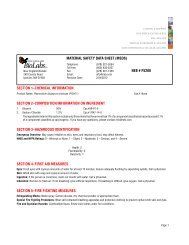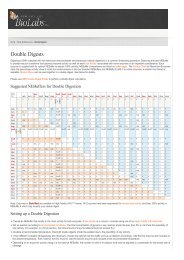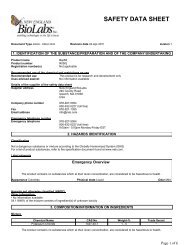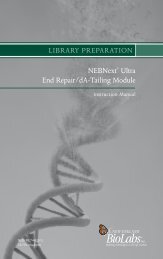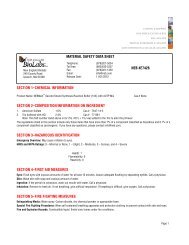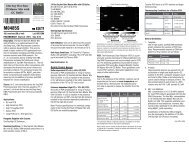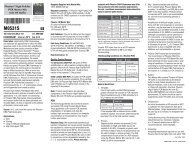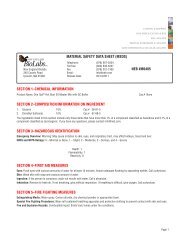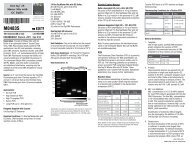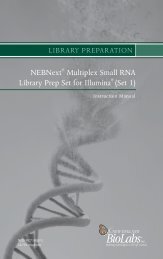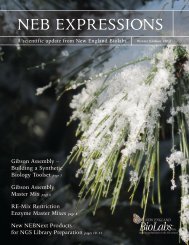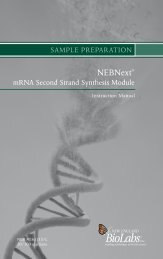Datasheet for OneTaq® Hot Start 2X Master Mix with Standard ...
Datasheet for OneTaq® Hot Start 2X Master Mix with Standard ...
Datasheet for OneTaq® Hot Start 2X Master Mix with Standard ...
You also want an ePaper? Increase the reach of your titles
YUMPU automatically turns print PDFs into web optimized ePapers that Google loves.
OneTaq <strong>Hot</strong> <strong>Start</strong><br />
<strong>2X</strong> <strong>Master</strong> <strong>Mix</strong> <strong>with</strong><br />
<strong>Standard</strong> Buffer<br />
M0484S 006120513111<br />
M0484S<br />
1-800-632-7799<br />
info@neb.com<br />
www.neb.com<br />
100 reactions (50 µl vol) Lot: 0061205<br />
RECOMBINANT Store at –20°C Exp: 11/13<br />
Description: OneTaq <strong>Hot</strong> <strong>Start</strong> <strong>2X</strong> <strong>Master</strong> <strong>Mix</strong><br />
<strong>with</strong> <strong>Standard</strong> Buffer is an optimized blend of<br />
Taq and Deep Vent DNA Polymerases combined<br />
R<br />
<strong>with</strong> an aptamer-based inhibitor. This enzyme<br />
blend is ideally suited to routine PCR applications<br />
from templates, including pure DNA solutions,<br />
bacterial colonies and cDNA products. The<br />
3´→5´ exonuclease activity of Deep Vent DNA<br />
Polymerase increases the fidelity and robust<br />
amplification of Taq DNA Polymerase (1). The<br />
hot start nature of the enzyme offers convenience<br />
<strong>with</strong> decreased interference from primer dimers<br />
and secondary products. The convenient master<br />
mix <strong>for</strong>mulation contains dNTPs, MgCl and other<br />
2<br />
buffer components and stabilizers listed below,<br />
requiring only the addition of primers and DNA<br />
template <strong>for</strong> robust amplification.<br />
Source: An E. coli strain that carries the Taq DNA<br />
Polymerase gene from Thermus aquaticus YT-1<br />
and an E. coli strain that carries the Deep Vent R<br />
DNA Polymerase gene from Pyrococcus species<br />
GB-D.<br />
Applications:<br />
• High Sensitivity PCR<br />
• High Throughput PCR<br />
• Routine PCR<br />
• AT-rich PCR<br />
• Colony PCR<br />
• Long PCR (up to ~6 kb genomic)<br />
Reaction Conditions: 1X OneTaq <strong>Hot</strong> <strong>Start</strong> <strong>Master</strong><br />
<strong>Mix</strong> <strong>with</strong> <strong>Standard</strong> Buffer, DNA template and primers<br />
in a total reaction volume of 50 µl.<br />
kb<br />
10.0<br />
8.0<br />
6.0<br />
5.0<br />
4.0<br />
3.0<br />
2.0<br />
1.5<br />
1.0<br />
0.5<br />
1X OneTaq <strong>Hot</strong> <strong>Start</strong> <strong>Master</strong> <strong>Mix</strong> <strong>with</strong><br />
<strong>Standard</strong> Buffer:<br />
20 mM Tris-HCI (pH 8.9)<br />
1.8 mM MgCl 2<br />
22 mM NH 4 Cl 2<br />
22 mM KCI<br />
0.2 mM dNTPs<br />
5% Glycerol<br />
0.06% IGEPAL ® CA-630<br />
0.05% Tween-20<br />
25 units/ml OneTaq <strong>Hot</strong> <strong>Start</strong> DNA Polymerase<br />
Unit Definition: One unit is defined as the amount<br />
of enzyme that will incorporate 15 nmol of dNTP<br />
into acid insoluble material in 30 minutes at 75°C.<br />
Unit Assay Conditions: 1X ThermoPol Reaction<br />
Buffer, 200 µM dNTPs including [ 3 H]-dTTP and<br />
200 µg/ml activated Calf Thymus DNA.<br />
Heat Inactivation: No<br />
Quality Control Assays<br />
5 kb Lambda PCR: 25 cycles of PCR amplification<br />
of 5 ng Lambda DNA <strong>with</strong> 1X OneTaq <strong>Hot</strong> <strong>Start</strong><br />
<strong>Master</strong> <strong>Mix</strong> <strong>with</strong> <strong>Standard</strong> Buffer in a 25 µl reaction<br />
in the presence of 0.2 µM primers resulted in the<br />
expected 5 kb product.<br />
Note: Product specifications <strong>for</strong> individual components<br />
in the OneTaq <strong>Hot</strong> <strong>Start</strong> <strong>2X</strong> <strong>Master</strong> <strong>Mix</strong> <strong>with</strong><br />
<strong>Standard</strong> Buffer are available separately.<br />
M<br />
Room Temperature Incubation<br />
5 Minutes<br />
50 Minutes<br />
AT-rich<br />
<strong>Standard</strong><br />
AT-rich<br />
<strong>Standard</strong><br />
%GC<br />
Amplification of a selection of sequences <strong>with</strong> varying GC content from<br />
human and C. elegans genomic DNA using OneTaq <strong>Hot</strong> <strong>Start</strong> <strong>2X</strong> <strong>Master</strong><br />
<strong>Mix</strong> <strong>with</strong> <strong>Standard</strong> Buffer. The presence of absence of an extended room<br />
temperature incubation does not affect per<strong>for</strong>mance. GC content is<br />
indicated above gel. Marker M is the 1 kb DNA Ladder (NEB #N3232).<br />
M<br />
PCR<br />
The Polymerase Chain Reaction (PCR) is a powerful<br />
and sensitive technique <strong>for</strong> DNA amplification (2).<br />
Taq DNA Polymerase is an enzyme widely used in<br />
PCR (3). The following guidelines are provided to<br />
ensure successful PCR using New England Biolabs’<br />
OneTaq <strong>Hot</strong> <strong>Start</strong> <strong>2X</strong> <strong>Master</strong> <strong>Mix</strong> <strong>with</strong> <strong>Standard</strong> Buffer.<br />
These guidelines cover routine PCR reactions.<br />
Amplification of templates <strong>with</strong> high GC content,<br />
high secondary structure or low template concentrations<br />
may require further optimization.<br />
Reaction Setup:<br />
Due to the presence of the inhibitor, reactions can<br />
be assembled on the bench at room temperature<br />
and transferred to a thermocycler. No separate<br />
activation step is required to release the inhibitor<br />
from the enzyme.<br />
COMpOnent<br />
25 µl<br />
ReaCtiOn<br />
50 µl<br />
ReaCtiOn<br />
Final<br />
COnCentRatiOn<br />
OneTaq <strong>Hot</strong> <strong>Start</strong><br />
<strong>2X</strong> <strong>Master</strong> <strong>Mix</strong> <strong>with</strong><br />
<strong>Standard</strong> Buffer 12.5 µl 25 µl 1X<br />
10 µM Forward Primer 0.5 µl 1 µl 0.2 µM<br />
10 µM Reverse Primer 0.5 µl 1 µl 0.2 µM<br />
Template DNA variable variable
5. Annealing:<br />
The annealing step is typically 15–60 seconds.<br />
Annealing temperature is based on the T m of<br />
the primer pair and is typically 45–68°C. Annealing<br />
temperatures can be optimized by doing a<br />
temperature gradient PCR starting 5°C below<br />
the calculated T m .<br />
6. Extension:<br />
The recommended extension temperature is<br />
68°C. Extension times are generally 1 minute<br />
per kb. A final extension of 5 minutes at 68°C<br />
is recommended.<br />
7. Cycle Number:<br />
Generally, 25–35 cycles yields sufficient product.<br />
Up to 45 cycles may be required to detect<br />
low copy number targets.<br />
8. 2-step PCR:<br />
When primers <strong>with</strong> annealing temperatures<br />
of 68°C or above are used, a 2-step thermocycling<br />
protocol (combining annealing and<br />
extension into one step) is possible.<br />
9. PCR Product:<br />
The majority of the PCR products generated<br />
using OneTaq DNA Polymerase contain dA<br />
overhangs at the 3´ end; there<strong>for</strong>e the PCR<br />
products can be ligated to dT/dU-overhang<br />
vectors.<br />
Notes:<br />
OneTaq <strong>Hot</strong> <strong>Start</strong> <strong>2X</strong> <strong>Master</strong> <strong>Mix</strong> <strong>with</strong> <strong>Standard</strong><br />
Buffer is stable <strong>for</strong> fifteen freeze-thaw cycles when<br />
stored at –20°C.<br />
OneTaq <strong>Hot</strong> <strong>Start</strong> <strong>2X</strong> <strong>Master</strong> <strong>Mix</strong> <strong>with</strong> <strong>Standard</strong><br />
Buffer is also stable <strong>for</strong> one month at 4°C, so <strong>for</strong><br />
frequent use, an aliquot may be kept at 4°C.<br />
Page 2 (M0484)<br />
References:<br />
1. Barnes, W.M. (1994) Proc. Natl. Acad. Sci.<br />
USA, 91, 2216–2220.<br />
2. Saiki R.K. et al. (1985) Science, 230,<br />
1350–1354.<br />
3. Powell, L.M. et al. (1987) Cell, 50, 831–840.<br />
4. Sun, Y., Hegamyer, G. and Colburn, N. (1993)<br />
Biotechniques, 15, 372–374.<br />
5. Sarkar, G., Kapelner, S. and Sommer, S.S.<br />
(1990) Nucleic Acids Res. 18, 7465.<br />
Companion Products Sold Separately:<br />
Magnesium Chloride (MgCl 2 ) Solution<br />
#B9021S 6.0 ml<br />
OneTaq <strong>Hot</strong> <strong>Start</strong> <strong>2X</strong> <strong>Master</strong> <strong>Mix</strong> <strong>with</strong> GC Buffer<br />
#M0485S 100 Reactions<br />
#M0485L 500 Reactions<br />
OneTaq <strong>Hot</strong> <strong>Start</strong> Quick-Load ® <strong>2X</strong> <strong>Master</strong> <strong>Mix</strong><br />
<strong>with</strong> <strong>Standard</strong> Buffer<br />
#M0488S 100 Reactions<br />
#M0488L 500 Reactions<br />
OneTaq <strong>Hot</strong> <strong>Start</strong> Quick-Load ® <strong>2X</strong> <strong>Master</strong> <strong>Mix</strong><br />
<strong>with</strong> GC Buffer<br />
#M0489S 100 Reactions<br />
#M0489L 500 Reactions<br />
OneTaq DNA Polymerase<br />
#M0480S 200 units<br />
#M0480L 1,000 units<br />
#M0480X 5,000 units<br />
OneTaq <strong>Hot</strong> <strong>Start</strong> DNA Polymerase<br />
#M0481S 200 units<br />
#M0481L 1,000 units<br />
#M0481X 5,000 units<br />
Notice to Purchaser:<br />
Nucleic acid-based aptamers <strong>for</strong> use <strong>with</strong> thermophilic DNA<br />
polymerases are licensed exclusively by New England Biolabs,<br />
Inc. from SomaLogic, Inc. (See Patent Nos. 5,475,096;<br />
5,670,637; 5,696,249; 5,874,557; and 5,693,502). New<br />
England Biolabs, Inc. gives the Buyer/User a non-exclusive<br />
license to use the aptamer-based OneTaq <strong>Hot</strong>-<strong>Start</strong> DNA<br />
Polymerase <strong>for</strong> RESEARCH PURPOSES ONLY. Commercial<br />
use of the aptamer-based OneTaq <strong>Hot</strong>-<strong>Start</strong> DNA Polymerase<br />
requires a license from New England Biolabs, Inc. Please<br />
contact busdev@neb.com <strong>for</strong> more in<strong>for</strong>mation.<br />
The purchase of this product also conveys to the purchaser<br />
only the limited, non-transferable right to use the purchased<br />
quantity of the product <strong>for</strong> the purchaser’s own research by<br />
the purchaser only under the following U.S. patent claims and<br />
<strong>for</strong>eign counterpart patent claims: U.S. Patent No. 5,436,149<br />
(claims 6-16). No rights are granted to the purchaser to sell,<br />
modify <strong>for</strong> resale or otherwise transfer this product, either<br />
alone or as a component of another product, to any third<br />
party. Takara Bio reserves all other rights, and this product<br />
may not be used in any manner other than as provided herein.<br />
For in<strong>for</strong>mation on obtaining a license to use this product <strong>for</strong><br />
purposes other than research, please contact Takara Bio Inc.,<br />
Seta 3-4-1, Otsu, Shiga 520-2193, Japan (Fax +81-77-453-<br />
9254).<br />
IGEPAL ® is a registered trademark of Rhodia Operations.


